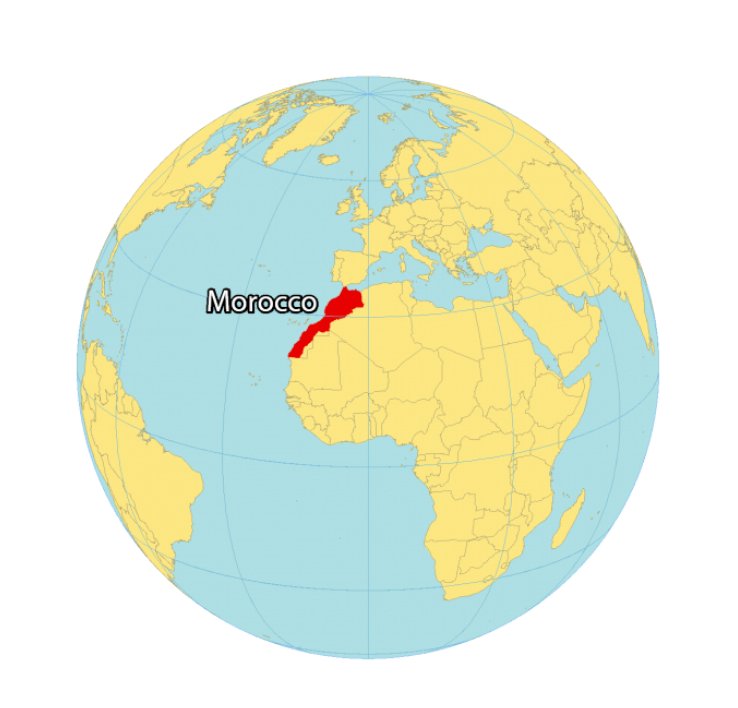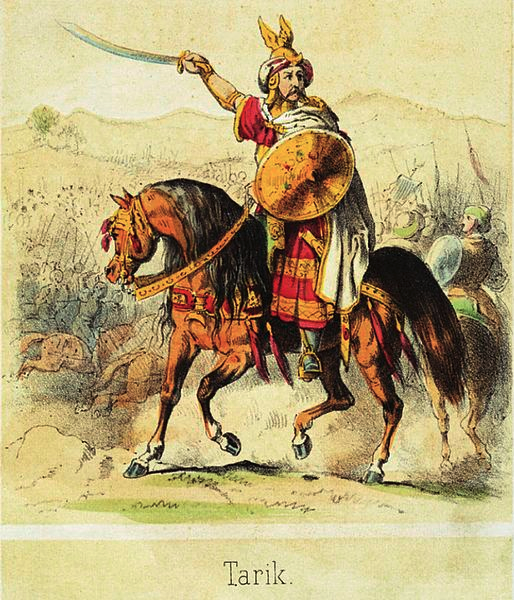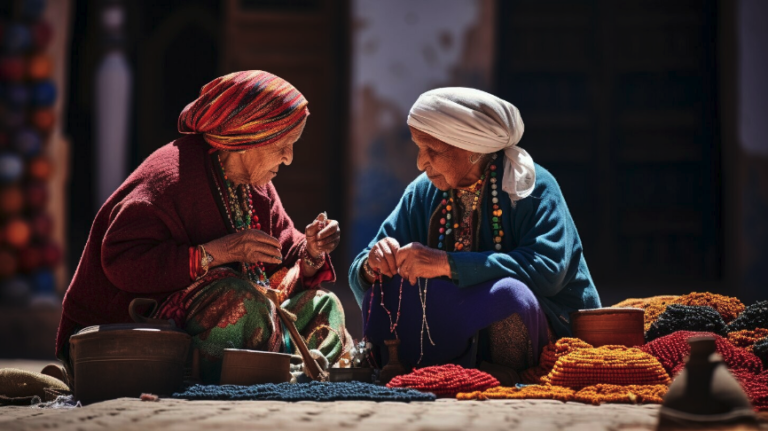The intriguing influence of Berber culture on Morocco’s enthralling history is an enduring enigma that has long captivated scholars and historians alike. The Berbers, a diverse and ancient people with roots deeply embedded in the North African region, have shaped Morocco’s cultural landscape for centuries. Their rich traditions, language, art, architecture, and culinary heritage have indelibly left their mark on this captivating country.
Berber culture in Morocco can be traced back to its origins, which date back thousands of years. The Bedouin-like lifestyle of the early Berber tribes fostered a strong sense of community and resilience in the face of adversity. Their nomadic existence allowed them to adapt to various geographical landscapes, leading to their mastery of survival skills and resourcefulness. This innate ability to thrive in harsh environments laid the foundation for their unique cultural identity that continues to shape Morocco today.
The allure of Berber culture lies not only in its rich linguistic traditions but also in its profound impact on Moroccan art and architecture. From intricate geometric patterns adorning mosques and palaces to vibrant rugs handwoven with meticulous precision, the influence of Berber aesthetics can be seen throughout the country’s architectural marvels. Moreover, traditional Berber crafts such as pottery-making and jewelry design showcase a remarkable attention to detail that reflects their deep appreciation for beauty and craftsmanship.
In conclusion, recognizing the influential role played by Berber culture in shaping Morocco’s history is imperative when exploring this enchanting nation’s past. By delving into their origins, language, artistic expressions, and culinary heritage, one gains a deeper understanding of how this diverse group has imbued Morocco with its distinct character over time.
As you embark on this exploration into the fascinating world of Moroccan history intertwined with Berber culture, prepare yourself for a journey filled with wonderment and discovery.
Key Takeaways
- Berber culture in Morocco has had an enduring influence on the country’s history.
- The traditions, language, art, architecture, and culinary heritage of the Berbers have shaped Morocco’s cultural landscape for centuries.
- The Berber community has a strong sense of community and resilience, which has allowed them to adapt to different environments and maintain their cultural practices.
- Berber culture is seen in various aspects of Moroccan society, including music, textiles, fashion, and cuisine.
The Origins of Berber Culture in Morocco
The fascinating origins of Berber culture in Morocco can be traced back thousands of years. The Berbers, also known as Amazighs, are the indigenous people of North Africa and have a rich history that predates the Arab conquest of the region.
The origins of Berber culture in Morocco can be traced to prehistoric times when they inhabited the land as hunter-gatherers and later evolved into farmers.
The evolution of Berber culture in Morocco is closely linked to their interactions with various civilizations throughout history. Influences from ancient Egyptians, Phoenicians, Romans, and Vandals shaped their cultural practices, language, and traditions. These interactions resulted in a unique blend of indigenous customs and foreign influences that still define Berber culture today.
One significant aspect of Berber culture is its strong connection to nature and traditional agricultural practices. The Berbers developed sophisticated farming techniques adapted to the diverse landscapes of Morocco, including terraced agriculture in mountainous regions and oasis farming in desert areas. Their knowledge of irrigation systems allowed them to cultivate crops such as wheat, barley, olives, figs, dates, and citrus fruits.
As we transition into discussing the role of Berber language and traditions in Moroccan history, it is important to acknowledge how the origins and evolution of Berber culture have shaped their identity over time. From their early beginnings as hunter-gatherers to becoming skilled farmers influenced by various civilizations, the roots of Berber culture run deep within Morocco’s history.
The Role of Berber Language and Traditions
Explore the fascinating impact that the language and customs of the indigenous people have had on shaping Morocco’s rich past. The Berber language, also known as Tamazight, has played a significant role in preserving the cultural heritage of Morocco.
Despite centuries of Arabization efforts, Berber communities have managed to maintain their unique language through oral tradition and, more recently, written forms. Efforts to promote Berber language preservation have gained momentum in recent years, with the recognition of Tamazight as an official language in 2011. This recognition has not only contributed to the revitalization of Berber culture but also serves as a testament to its enduring influence on Moroccan history.
In addition to language, Berber traditions and customs continue to shape Moroccan society. Cultural festivals are a vibrant expression of Berber identity and play a crucial role in reinforcing community bonds. These festivals showcase various aspects of Berber culture, including music, dance, handicrafts, and culinary delights.
One such festival is the Imilchil Marriage Festival held annually in September. This event celebrates traditional Berber wedding ceremonies and attracts visitors from all over Morocco and beyond. By participating in these festivals, both locals and tourists gain a deeper appreciation for the richness and diversity of Moroccan culture.
The preservation of the Berber language and customs is not only important for historical reasons but also for fostering social cohesion within modern-day Morocco. Embracing linguistic diversity contributes to a more inclusive society where all citizens can express themselves freely in their native tongue. Furthermore, celebrating cultural traditions helps bridge generational gaps by passing down ancient knowledge from one generation to another.
As we transition into discussing ‘Berber influence on Moroccan art and architecture,’ it is clear that language and customs are deeply intertwined with artistic expressions across different mediums. From intricately designed carpets featuring traditional motifs to stunning architectural marvels adorned with ornate carvings inspired by ancient legends – these artistic creations reflect both historical influences and the contemporary vibrancy of Berber culture.
Through their language, customs, and artistic expressions, the Berber people have left an indelible mark on Morocco’s history and continue to shape its present-day identity.
Berber Influence on Moroccan Art and Architecture
Discover how the vibrant art and architecture of Morocco are infused with the rich traditions and unique aesthetic of the Berber people. The influence of Berber culture on Moroccan art and architecture can be seen in various aspects, including music and textiles.
Berber influence on Moroccan music is evident in the rhythmic beats, melodic tunes, and distinct instruments used in traditional Moroccan music. The Amazigh language, spoken by the Berber people, has also influenced the lyrics and storytelling in Moroccan songs.
Moroccan textiles also bear witness to the strong influence of Berber culture. Traditional Berber rugs, known as ‘Beni Ourain,’ are famous for their intricate designs and hand-woven craftsmanship. These rugs often feature geometric patterns and symbols that hold deep cultural significance for the Berber community. The colors used in these textiles reflect the natural landscapes of Morocco, such as earthy tones inspired by desert dunes or vibrant hues reminiscent of lush oases.
The integration of Berber influences into Moroccan art and architecture goes beyond music and textiles. It can be observed in the decorative motifs found in mosques, palaces, and public buildings throughout Morocco. Zellij tiles, a distinctive feature of Moroccan architecture, often incorporate geometric patterns similar to those found in traditional Berber crafts. These intricate tilework designs not only add beauty but also symbolize unity as they are made up of individual pieces coming together to form a cohesive whole.
As we transition into exploring ‘the culinary heritage of Berber culture in Morocco,’ it is clear that every aspect of Moroccan life is deeply intertwined with its rich history shaped by the diverse influences from different cultures over time. From language to art to cuisine, each element tells a story reflecting centuries-old traditions passed down through generations.
The Culinary Heritage of Berber Culture in Morocco
One fascinating aspect of the culinary heritage in Morocco is how Berber cuisine incorporates a diverse range of ingredients, with over 20 different types of spices commonly used. This rich culinary tradition reflects the historical and cultural influences that have shaped Moroccan cuisine over centuries.
Traditional Berber dishes often feature a combination of sweet and savory flavors, creating a unique taste profile that is both comforting and exotic.
The traditional dishes of Berber culture reflect the resourcefulness and ingenuity of the people who have inhabited this land for generations. One can imagine the aromatic scents wafting from clay pots simmering over open fires, as families gather around to share a meal prepared with love and care.
The use of local, seasonal ingredients is at the heart of Berber cooking, ensuring that each dish is bursting with freshness and flavor.
To truly understand the significance of Berber culinary traditions, one must experience firsthand the sensory delights they offer. Picture yourself savoring a warm bowl of tagine, a slow-cooked stew made with tender meat or vegetables, infused with fragrant spices like cumin, coriander, and ginger. The aroma alone will transport you to another time and place.
Or imagine biting into a freshly baked khobz bread, its crusty exterior giving way to soft dough inside – an experience that encapsulates the simplicity yet complexity of Berber cuisine.
Berber culinary traditions not only nourish the body but also feed the soul. They evoke feelings of warmth, comfort, and connection to nature and community. As you sit down to enjoy a meal in Morocco, surrounded by vibrant colors and lively conversation, you can’t help but feel an overwhelming sense of gratitude for this ancient culture’s enduring legacy.
As we transition into discussing the enduring legacy of Berber culture in Morocco, it’s important to acknowledge how food has played an integral role in preserving this cultural heritage throughout history. The culinary traditions passed down through generations serve as a tangible link to the past, reminding us of the resilience and adaptability of the Berber people. Just as flavors meld together in a tagine, so too do the influences of various cultures blend harmoniously to create Morocco’s vibrant and diverse identity.
The Enduring Legacy of Berber Culture in Morocco
Immerse yourself in the vibrant tapestry of Morocco’s enduring legacy, where ancient traditions and customs have stood the test of time. The influence of Berber culture on Morocco’s history is undeniable, shaping various aspects of Moroccan society, including fashion and music. Both influences are deeply rooted in the rich heritage of the Berber people, reflecting their resilience and creativity.
Berber culture has left an indelible mark on Moroccan fashion. Traditional Berber clothing is characterized by its intricate embroidery, vibrant colors, and use of natural materials such as wool and silk. This unique style has influenced contemporary Moroccan fashion designers who incorporate these elements into their designs. From traditional caftans to modern interpretations inspired by Berber motifs, Moroccan fashion showcases a fusion of old and new that pays homage to the country’s cultural roots.
Similarly, Berber music traditions continue to resonate throughout Morocco. Music is an integral part of Berber culture, serving as a means for storytelling, celebration, and self-expression. The mesmerizing rhythms and soulful melodies are infused with indigenous instruments like the bendir (a frame drum) and the guembri (a three-stringed lute). These musical traditions have not only survived but thrived over centuries, captivating both locals and visitors alike. Today, you can experience live performances that showcase the beauty and complexity of Berber music at festivals or traditional gatherings across Morocco.
To further visualize these influences in Moroccan society, consider the following table:
| Aspects | Influences |
|---|---|
| Fashion | – Intricate embroidery |
| – Vibrant colors | |
| – Use of natural materials | |
| Music | – Mesmerizing rhythms |
| – Soulful melodies | |
| – Indigenous instruments |
The enduring legacy of Berber culture in Morocco is evident in both its fashion and music scenes. By embracing and preserving these influences, Morocco continues to honor its past while evolving in the present. Whether through the intricate designs of a caftan or the captivating melodies of Berber music, the Berber culture remains an integral part of Moroccan identity and serves as a testament to the resilience and creativity of its people.
Frequently Asked Questions
How did the Berber culture in Morocco impact the country’s political history?
The Berber culture in Morocco shaped political history like a flowing river carving its path. Its economic impact fostered trade and prosperity, while cultural traditions forged a cohesive social structure that influenced political dynamics.
What are some unique customs and rituals practiced by the Berber people in Morocco?
Berber traditional clothing, music, and dance are integral to the unique customs and rituals of the Berber people in Morocco. Their clothing reflects their cultural identity, while music and dance play a significant role in their social gatherings and celebrations.
How has the Berber language evolved over time and what is its current status in Morocco?
The Berber language has evolved over time due to various influences, but it remains significant in Moroccan society. Its evolution reflects societal and cultural changes, while its importance is seen in language preservation efforts and recognition by the government.
What are some famous examples of Berber-influenced art and architecture in Morocco?
Step into a vibrant tapestry of Berber culture in Morocco. Explore the intricate designs of famous Berber-influenced art and architecture, witness the influences on Moroccan fashion, and immerse yourself in the rhythmic melodies of Berber music.
How has the Berber culinary heritage influenced Moroccan cuisine today?
Berber culinary techniques and traditional Berber dishes have greatly influenced Moroccan cuisine today. The use of spices, such as cumin and coriander, and cooking methods like slow braising are examples of this enduring heritage.
Conclusion
In conclusion, the influence of Berber culture on Morocco’s history is undeniable. From its origins in ancient times to its enduring legacy today, Berber culture has shaped every aspect of Moroccan society.
The Berber language and traditions have played a crucial role in preserving the unique identity of the country, while also influencing the development of Moroccan art and architecture.
The culinary heritage of Berber culture is another testament to its profound impact on Morocco. The traditional dishes and cooking techniques passed down through generations reflect not only the rich flavors and spices of the region but also the cultural values and customs that have been cherished for centuries.
Despite centuries of outside influences, Berber culture has managed to maintain its authenticity and continue to thrive in modern-day Morocco. Its resilience is a testament to the strength and pride of the Berber people who have left an indelible mark on Moroccan history.
Through their language, traditions, art, architecture, and cuisine, the Berbers have woven a tapestry that tells a story of resilience, adaptability, and cultural richness. It is this deep-rooted connection to their heritage that sets Morocco apart from other nations in North Africa.
As you explore Morocco’s bustling markets or wander through its ancient medinas, take a moment to appreciate the lasting influence of Berber culture. It’s through understanding and embracing this diverse heritage that we can truly appreciate the depth and complexity of Morocco’s history.

The Editorial Team is a passionate group of Morocco enthusiasts dedicated to sharing the beauty, culture, and wonders of this captivating country. With diverse backgrounds and a deep love for travel, we strive to bring you engaging and informative content that inspires your Moroccan adventures. From uncovering hidden gems and sharing local insights to exploring mouthwatering cuisine and showcasing the vibrant lifestyle, our team is committed to providing you with valuable resources and exciting stories that enhance your exploration of Morocco. Join us on this journey as we celebrate the rich heritage and unforgettable experiences that make Morocco truly special.



